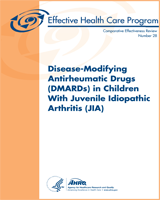NCBI Bookshelf. A service of the National Library of Medicine, National Institutes of Health.
Kemper AR, Coeytaux R, Sanders GD, et al. Disease-Modifying Antirheumatic Drugs (DMARDs) in Children With Juvenile Idiopathic Arthritis (JIA) [Internet]. Rockville (MD): Agency for Healthcare Research and Quality (US); 2011 Sep. (Comparative Effectiveness Reviews, No. 28.)
This publication is provided for historical reference only and the information may be out of date.

Disease-Modifying Antirheumatic Drugs (DMARDs) in Children With Juvenile Idiopathic Arthritis (JIA) [Internet].
Show detailsA succinct summary of the results of this review of the comparative benefits and harms of DMARDs for children with JIA is presented in the tables that follow. First, we provide an aggregated view of the strength of evidence and brief conclusions (Table 12). Next, we describe the nature and quality of the evidence for Key Questions 1, 2, and 4 in a format recommended by the GRADE committee (Tables 13-16).7 We then provide a tabular summary of the evidence for Key Question 5 (Table 17). Finally, we comment on the applicability of our findings.
Table 12
Summary of the evidence on comparative effectiveness and harms of DMARDs for childhood JIA.
Table 13
GRADE summary table for key question 1—biologic DMARDs.
Table 14
GRADE summary table for key question 1—non-biologic DMARDs.
Table 15
GRADE summary table for key question 2.
Table 16
GRADE summary table for key question 4.
Table 17
Evidence summary table for key question 5.
GRADE summary tables were developed to describe the strength of evidence. For Key Question 1, separate GRADE summary tables are presented for the biologic and non-biologic DMARDs. We identified six randomized discontinuation trials that were conducted for the biologic DMARDs. Unlike RCTs or prospective cohort trials, randomized discontinuation trials evaluate the risk of worsening disease among those who initially responded to therapy. Because of this fundamental difference, we present a separate GRADE strength of evidence rating for the randomized discontinuation studies for each outcome. GRADE summary tables do not apply to Key Question 3 or Key Question 5. Findings from Key Question 3 are summarized in Tables 7 (Parts 1-3), under Results, and in Appendix E. Findings from Key Question 5 are summarized by outcome measure in Table 16.
Applicability was assessed for Key Question 1 only. Insufficient evidence was available to rate applicability for Key Questions 2 and 3, and Key Question 4 and 5 were not amenable to assessment of applicability. For Key Question 1, we assessed applicability as follows:
- Population: There was variation across studies in the definition of JIA and both duration and severity of illness, likely reflecting the range of patients seen in usual practice. However, six of the studies of the biologic DMARDs were randomized discontinuation studies, which include patients who have responded to the intervention.
- Intensity or quality of treatment: With the exception of methotrexate, the non-biologic DMARDs are less often used than the newer biologic DMARDs. The intensity of treatment in the studies of the biologic DMARDs is consistent with current recommendations.
- Choice of, and dosing of, the comparator: Methotrexate, a non-biologic DMARD, is a standard treatment for JIA. Six of the studies of the biologic DMARDs included methotrexate as a comparator; none of the studies of the non-biologic DMARDs included methotrexate as a comparator. The reasons for use or dose escalation of the comparator drugs were usually not described.
- Outcomes: The most commonly reported outcome measures were laboratory indicators of inflammation (e.g., ESR) or the ACR Pediatric 30. The ACR Pediatric 30 blends several relevant outcomes (e.g., active joint count, functional status, pain), but is not normally used in daily clinical practice. As described for Key Question 5, new instruments to better assess response to therapy and changes in health-related quality of life are in development.
- Timing of followup: Five of the studies of biologic DMARDs and five of the studies of non-biologic DMARDs actively followed subjects for more than 6 months. This would allow sufficient time to detect clinically important benefits and may be long enough to identify important harms.
- Summary and Discussion - Disease-Modifying Antirheumatic Drugs (DMARDs) in Child...Summary and Discussion - Disease-Modifying Antirheumatic Drugs (DMARDs) in Children With Juvenile Idiopathic Arthritis (JIA)
Your browsing activity is empty.
Activity recording is turned off.
See more...